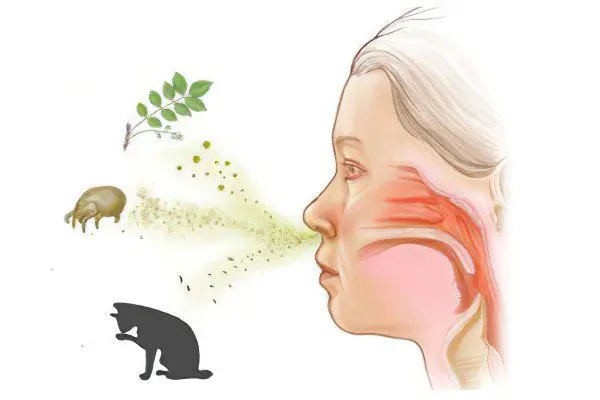Contents
Allergic pharyngitis is an inflammation of the mucous membrane of the throat caused by allergens. The disease is a widespread pathology of the upper respiratory tract and rarely occurs in isolation – it is usually combined with allergic rhinitis. The disease is persistent and difficult to treat. Most often, allergic pharyngitis affects young people, the disease worsens their quality of life and reduces their efficiency.
Causes of allergic pharyngitis

The causes of allergic pharyngitis are diverse, so the disease belongs to polyetiological pathologies. The connection between inflammation of the mucous membrane of the throat and the suppression of local and systemic immunity has been clearly established. Naturally, in order for an allergic reaction to start, contact with the allergen is necessary.
The most common pathogenic agents that provoke pharyngitis are:
Book and house dust containing dust mites;
Allergens present in plant pollen;
Animal hair, particles of their epidermis, saliva and dandruff;
Insects;
Yeast and mold fungi;
Allergens from food and drugs.
Symptoms of allergic pharyngitis can occur and intensify when inhaling strong odors, such as perfume, exhaust fumes, tobacco smoke, etc. If the allergy is seasonal, then pharyngitis will worsen during the period when the allergen plant blooms. Weather conditions affect the severity of the symptoms of the disease, so they will be stronger during the wind, when you are outside the city.
If a person has allergic pharyngitis as a reaction to mold and yeast fungi, then it will worsen in autumn and spring. It was at this time that fungal spores show maximum activity, provided they live in central Russia.
Factors provocateurs of allergic pharyngitis can be distinguished as follows:
Changes in the composition of the microflora of the mucous membrane of the respiratory tract in general and the throat in particular. A special role in this regard is played by inflammatory processes in the nasopharynx, provoked by viral and bacterial agents;
Gastrointestinal tract diseases;
Violations in the functioning of cellular and humoral immunity;
Cardiovascular diseases;
kidney disease;
Osteochondrosis of the cervical spine;
Allergization of the body as a whole;
Living in areas with unfavorable environmental conditions;
Transfer of predisposition to allergic reactions by inheritance.
Symptoms of allergic pharyngitis
Symptoms of allergic pharyngitis are as follows:
Feeling of sore throat;
Sensation of the presence of a foreign body in the throat;
Sore throat;
Paroxysmal cough;
The presence in the throat of viscous thick mucus;
Redness and swelling of the back of the throat;
Periodically appearing nasal congestion, impaired nasal breathing;
Copious flow of mucus from the nose;
Attacks of sneezing;
Itching in the eyes, in the throat, in the nose;
Perhaps a combination of exacerbation of the disease with conjunctivitis. At the same time, the eyes turn red, itch, lacrimation intensifies;
A person’s sleep is disturbed, headaches, weakness appear, irritability increases.
Allergic pharyngitis rarely occurs in isolation, most often the nasal mucosa is involved in the pathological process. This condition is called allergic rhinopharyngitis.
The severity of the course of the disease is influenced by the individual sensitivity of the body to various allergens, general health, exogenous factors (living in environmentally unfavorable areas, working at hazardous enterprises).
The danger of allergic inflammation of the mucous membrane of the throat lies in the fact that it can lead to the development of chronic foci of infection with sinusitis, polyposis, otitis media, tonsillitis, etc.
Diagnosis of allergic pharyngitis
Diagnosis of allergic pharyngitis is carried out with the obligatory participation of not only an otolaryngologist, but also an allergist. The anamnesis, the clinical picture of the disease is carefully collected and analyzed. A pharyngoscopy is performed, during which the specialist visualizes an edematous hyperemic back wall of the throat, viscous, sometimes foamy mucus.
To clarify the type of allergen that causes a pathological reaction, skin tests are performed, which reveal the patient’s hypersensitivity to a particular agent. Also indicative is the determination of the level of allergen-specific IgE in the blood serum. For this, there are allergosorbent tests – RAST and radioimmunosorbent tests – PRIST.
Treatment of allergic pharyngitis

Treatment of allergic pharyngitis is reduced mainly to conservative therapy:
Termination of contact with the allergen;
Medical correction;
Specific allergen immunotherapy.
After the allergen has been identified, it is necessary to limit contact with it as much as possible. It should be noted that even the maximum isolation of the allergen will give a positive result only after a few months. However, it is not always possible to completely limit the patient’s contact with a pathogenic agent, so it is necessary to strengthen drug therapy.
Allergen-specific immunotherapy is a modern method of treating allergic pharyngitis. It comes down to treating the patient with increasing doses of the allergen, which is most often injected subcutaneously.
This procedure is carried out only by an allergist in a specialized office and according to the following indications:
Inefficiency of medical correction;
Refusal of the patient to take medication;
Negative effects of drug treatment;
A clear definition of the allergen and the achievement of a stable remission of the disease.
Allergic pharyngitis medications
As for drug correction, it involves taking antihistamines, corticosteroids, cromones (mast cell membrane stabilizers), vasoconstrictor drugs, anticholinergics.
Experts prefer second-generation antihistamines – Akrivastine, Loratadin, Terfenadine, Cetirizine, Levocetirizine. They have a pronounced effect, well eliminate the symptoms of allergic pharyngitis and are safer in terms of the development of side effects than when using first-generation antihistamines (Clemastin, Promethazine, Hydroxyzine, etc.).
Cromones such as Ketotifen and nedocromil sodium are used to prevent allergic pharyngitis. The effect of their reception comes slowly, after 7-14 days. However, the undoubted advantage of mast cell membrane stabilizers is their safety. This allows the use of cromones in the treatment of pregnant women and children.
Vasoconstrictor drugs are used only if the patient has allergic rhinitis. These can be drugs such as Oxymetazoline, Phenylephrine, Epinephrine, etc. Do not exceed the recommended dosage and use these drugs for more than 7 days in a row, as they contribute to the development of addiction and additionally irritate the mucous membrane of the throat.
A prerequisite is the regular flushing of mucus and allergens that have settled in the respiratory tract. For this, decoctions of medicinal herbs are used (if they are not allergic), Miramistin, Furacilin solution, soda solution, sea water (Aqua Lor, Aqua Maris), isotonic solution, etc.
The presence of an antiseptic or antibacterial component in the composition of the gargle can reduce the severity of inflammation, and is also a prevention of bacterial complications.
As for the intake of glucocorticosteroids, they are used in the form of inhalations in the development of bronchial asthma against the background of allergic inflammation. Independent use of such medicines is unacceptable.









